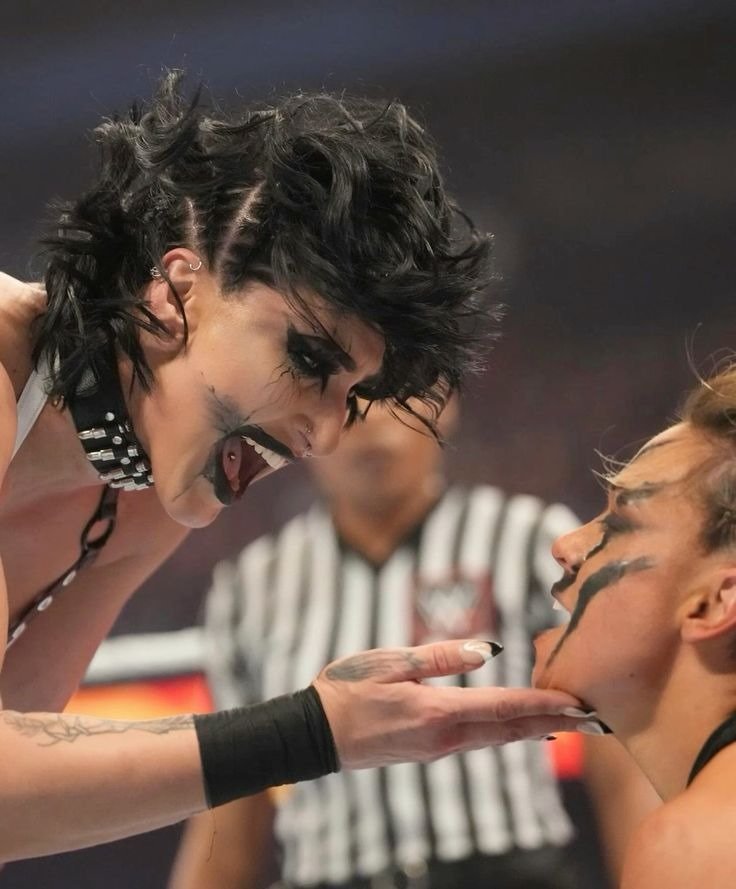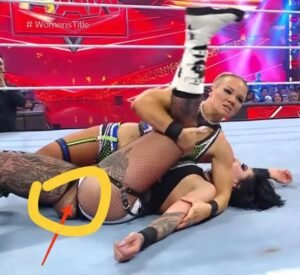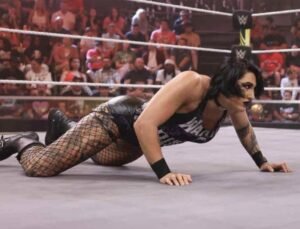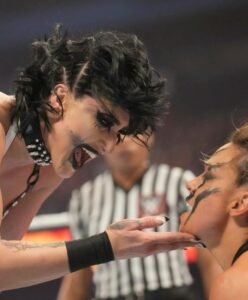
A Night of Peril: How a Live TV Stunt Gone Wrong Created a “Very Dangerous Situation” for Rhea Ripley and Exposed WWE’s Safety Protocols
 In the world of professional wrestling, the line between controlled chaos and genuine danger is always razor-thin. For a dominant champion like Rhea Ripley, whose entire aura is built on invincibility and brute force, that line is not just crossed; it’s obliterated on a weekly basis. However, this past Monday Night Raw, a segment designed to showcase her dominance nearly spiraled into a genuine catastrophe, creating what multiple sources backstage are describing as a “very dangerous situation” that has left the company embarrassed and facing serious questions about its safety protocols.
In the world of professional wrestling, the line between controlled chaos and genuine danger is always razor-thin. For a dominant champion like Rhea Ripley, whose entire aura is built on invincibility and brute force, that line is not just crossed; it’s obliterated on a weekly basis. However, this past Monday Night Raw, a segment designed to showcase her dominance nearly spiraled into a genuine catastrophe, creating what multiple sources backstage are describing as a “very dangerous situation” that has left the company embarrassed and facing serious questions about its safety protocols.
The incident occurred during what should have been a standard, albeit intense, contract signing for Ripley’s upcoming title defense. The segment involved Ripley, her challenger (a plucky but physically overmatched opponent), General Manager Adam Pearce, and several security guards tasked with keeping the peace. The script, as is customary, called for a physical altercation culminating in Ripley laying out her challenger and standing tall. But in a business where the slightest miscalculation can have dire consequences, the script was thrown out the window.
The pivotal moment came when Ripley, in a show of force, went to powerbomb her challenger through the signing table. This is a routine spot in modern wrestling, rehearsed and executed countless times. However, as Ripley lifted her opponent, one of the security guards—a local hire reportedly inexperienced with the specific mechanics of such a bump—stumbled backward, knocking awkwardly into the table. This caused the table to shift its position by mere inches. For anyone watching, it was unnoticeable. For the athletes in the ring, it was a potential disaster .
.
Ripley, committed to the move, adjusted her grip mid-air to try and correct the trajectory. Witnesses say the adjustment caused her to land awkwardly, with her head and neck whipping violently against the canvas as she completed the powerbomb. The sickening thud was audible even over the crowd’s roar. For a terrifying few seconds, Ripley did not move. The referee, following protocol, immediately called for the medical team, and the broadcast cut to a panicked-looking Adam Pearce backstage as the arena fell into a hushed, anxious silence.
The “Embarrassing” Aftermath: A Champion Exposed
The immediate danger was the physical well-being of Rhea Ripley. Fortunately, after several minutes of on-site medical attention, she was able to sit up and was eventually helped to the back, reportedly alert and oriented. Early diagnoses point to a severe stinger and whiplash, but the fear of a more serious neck or head injury was palpable.
The embarrassment for WWE, however, stems from multiple fronts:
-
The Breakdown of the Illusion: Rhea Ripley is “Mami.” She is the Eradicator. She is presented as an unstoppable force of nature. To see her vulnerable, hurt, and immobilized on the canvas—not as part of a storyline, but due to a real-life error—shatters the carefully constructed image of invincibility that is central to her character. It was a moment of unscripted, genuine vulnerability that the multi-million dollar production machine of WWE is designed to avoid at all costs. The image of their most dominant champion being stretchered out would have been a public relations nightmare of the highest order.
-
A Question of Safety and Preparation: The incident has ignited a firestorm of criticism internally regarding the use of temporary or local security personnel in physically demanding segments. While seasoned WWE performers are experts at protecting themselves and their opponents, introducing an unpredictable element like an untrained extra into a high-risk spot is being called “reckless” by several veterans backstage. The fact that a simple stumble by a security guard could have led to a career-ending injury for the company’s top female star is an enormous source of embarrassment and has prompted an immediate internal review of safety procedures for non-wrestling personnel involved in angles.
-
Live Television Panic: The prolonged silence, the frantic cuts to backstage, and the visible concern on the faces of everyone in the ring exposed a raw nerve on live television. For nearly five minutes, WWE lost control of its own narrative. Instead of a segment designed to build hype for a pay-per-view, the audience was given a front-row seat to a real-life medical emergency. This is the kind of unplanned reality that networks and advertisers fear, and it stands in stark contrast to the slick, controlled product WWE aims to deliver.
Backstage Fallout: Anger, Fear, and a Call for Change
In the hours following the broadcast, the backstage mood was described as a mixture of relief that Ripley’s injuries were not more severe and simmering anger over the circumstances that led to the incident.
“A star of Rhea’s magnitude should not be put in that position,” one veteran producer was quoted as saying. “We got lucky. Very lucky. That table shift could have ended differently. It’s embarrassing that a basic spot, something we do every week, was compromised by something so simple. It makes us all look amateurish.”
The incident has also reignited the ongoing debate about the escalating physical risks in modern wrestling. While Rhea Ripley’s style is built on power and impact, this scare serves as a stark reminder that no amount of skill can completely eliminate the inherent dangers of the profession. Many are now questioning whether the constant need for “memorable moments” and “crash TV” is pushing performers into unnecessarily risky situations.
For Rhea Ripley, the path forward involves recovery and a likely temporary hiatus from in-ring action. The embarrassment for her is personal and professional—a champion humbled not by an opponent, but by a fluke accident. For WWE, the embarrassment is systemic. It is a blow to their reputation for safety and production excellence.
The company now faces the difficult task of managing the narrative. How will they address Ripley’s absence? Will they acknowledge the real danger of the situation, or will they attempt to sweep it under the rug and incorporate it into a storyline? One thing is certain: the image of a motionless Rhea Ripley under the bright lights of Monday Night Raw is an image that will linger far longer than any scripted victory. It was a chilling moment of very real danger that exposed the fragile reality behind the spectacle, and for that, WWE has nobody to blame but itself.



